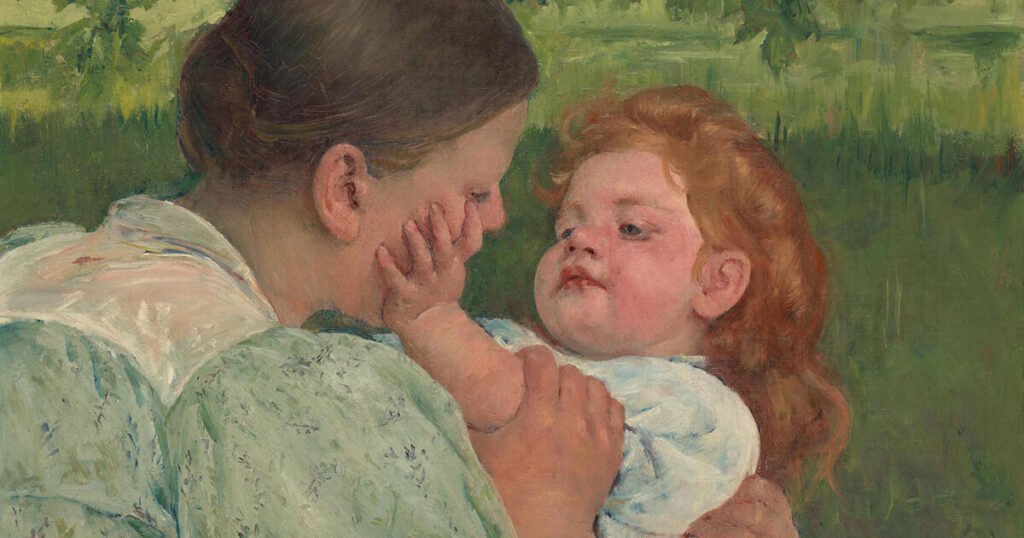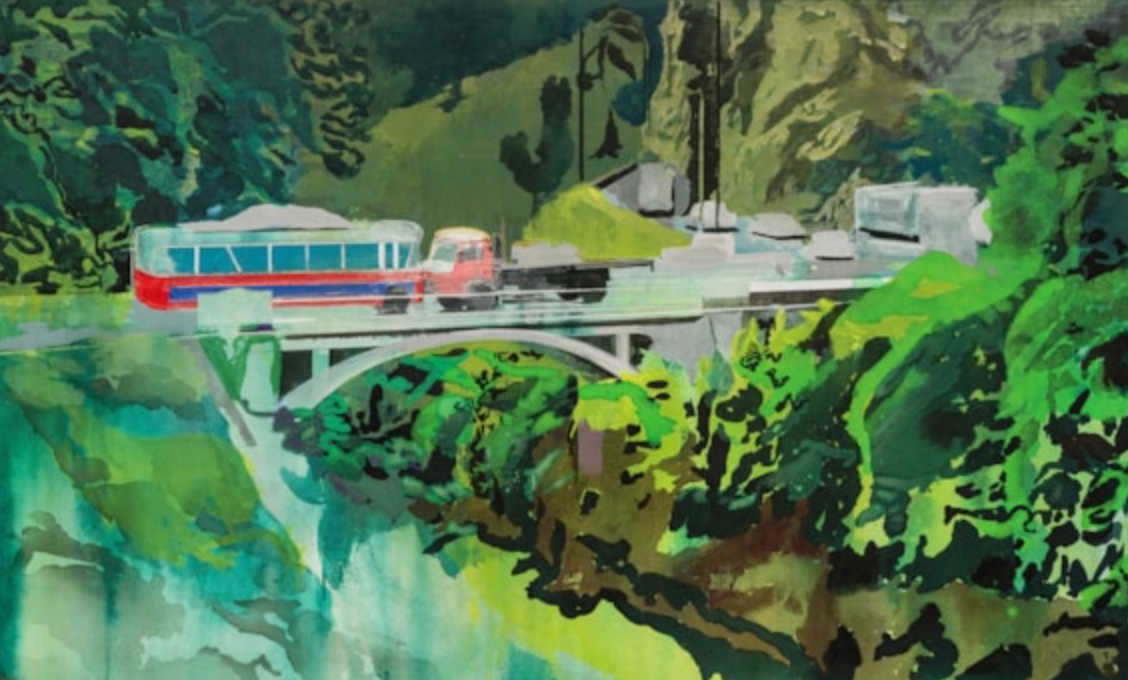Art
Olivia Horn
Mary Cassatt, Mother and Child (Maternal Kiss), 1896. Courtesy of the Philadelphia Museum of Art.
It would be unseemly behavior in a museum, but you’d be forgiven for wanting to nuzzle one of Mary Cassatt’s wondrously soft and textural pictures. Mother and Child (Maternal Kiss), a work on paper from 1896, is a particularly inviting candidate. The fulsome cheeks of its subjects, presumably a mother and daughter, are gently smushed together; wisps of silky hair are tucked into bows and buns; streaks of pastel sweep like taffy pulled across the paper.
In the popular imagination, this is where Cassatt’s work starts and ends—inside a cocoon of domesticity, or what the art historian Edgar Richardson once described as a “perpetual afternoon tea.” Mother and Child (Maternal Kiss) belongs to the collection of the Philadelphia Museum of Art (PMA), where a new survey of the American Impressionist’s work is on view through September 8th. “Mary Cassatt at Work” sets out to unsettle the notion of Cassatt as a painter of idyllic nursery scenes. It arose from a desire to “bring contemporary questions and conversation into the material,” as the exhibition’s co-curator Laurel Garber said in an interview. “There are ways to look afresh at her scenes that have…ossified into these—I think—tired readings.”
Mary Cassatt, Little Girl in a Blue Armchair, 1877–78. Courtesy of the National Gallery of Art, Washington, D.C.
“Mary Cassatt at Work” is undergirded by a contemporary feminist sensibility—a sensitivity to the historical underrecognition of so-called “women’s work.” Domestic labor, we are reminded, is essential: When Cassatt painted the home, she also painted the workplace. What’s more, because women of Cassatt’s socioeconomic status typically painted as an amateur pursuit, foregrounding the professionalism of her practice also adds an important feminist perspective. When Cassatt painted the home-as-workplace, she herself was working—not merely engaging in bourgeois hobbyism, a more socially sanctioned undertaking.
Certainly, Cassatt was a woman ahead of her time, and her work has been studied through a feminist art historical lens for decades. Today, fourth-wave popular feminism, with all its eagerness to claim individuals as icons, may be tempted to make her a feminist poster child. This exhibition has more modest aims; it largely avoids explicitly claiming Cassatt as a feminist. Still, it shines a light on aspects of the artist’s life and work that chime with contemporary ideas about women’s empowerment, at the level of both the individual and the collective.
Modern painter, modern life
Mary Cassatt, installation view of “Mary Cassatt at Work” at the Philadelphia Museum of Art, 2024. Photo by Timothy Tiebout. Courtesy of the Philadelphia Museum of Art.
Cassatt’s personal highlight reel is remarkable. Born in Pennsylvania in 1844, she studied at the Pennsylvania Academy of Fine Arts in Philadelphia before moving abroad to continue her artistic training. In Paris, she became friendly with Edgar Degas and was eventually invited to exhibit with the Impressionists, not once, but four times. She was the only American to do so, and one of only a handful of women. In 1904, Cassatt became the second woman artist to win the Légion d’honneur from the French government. In today’s parlance, she broke glass ceilings.
Impressionism was the painting of modern life, and Cassatt’s own life was thoroughly modern. Despite frequently depicting infants, the artist herself never married or had children. The exhibition takes pains to underscore her uncompromising commitment to professionalism—spurred on by her family’s insistence, beginning in 1878, that her practice be financially self-sustaining. “I am independent!” Cassatt once wrote, a quote now emblazoned on a gallery wall at the PMA. “I can live alone and I love my work.”
Utopian female cooperation
Reproduction of Mary Cassatt, Modern Woman, 1892–93. Courtesy of New York Public Library.
One of the most significant works of Cassatt’s career, Modern Woman (1892–93), is described by art historian Nicole Georgopulos in the exhibition catalogue as the artist’s “great opus on women’s liberation.” A large-scale mural commissioned for the Women’s Building at the 1893 World’s Fair in Chicago, it depicted an Edenic garden in which women worked together to harvest and circulate the fruits of the Tree of Knowledge. Modern Woman is preserved only in photographs, but in its allegorical vision of women’s education, we catch a glimpse of Cassatt’s interest in models of collectivity and networks of knowledge.
These themes show up at a smaller scale in Gathering Fruit, a print from the same year as the World’s Fair. Rendered in verdant botanical patterns, it features a woman on a ladder passing plucked grapes to a child cradled by a second woman. Here, Cassatt reclaims the figure of Eve and repositions knowledge as a source of strength—not sin—for women.
Women’s work
Mary Cassatt, In the Omnibus, 1890–91. Courtesy of the Cleveland Museum of Art.
Mary Cassatt, The Bath, 1890–91. Courtesy of the Art Institute of Chicago.
Mary Cassatt’s world was riddled with maternal gestures (work titles included Maternal Kiss, Maternal Caress)—but her images were, in many cases, fictitious. Cassatt’s “mothers” were often paid models, and she also frequently depicted “pink-collar” laborers, such as wet nurses and hired caregivers.
“Mary Cassatt at Work” suggests that the identities of Cassatt’s subjects, along with her compositional choices, undercut the sentimentality of these images. Thus, they get to the reality of motherhood, whether authentic or enacted: It is work. In Maternal Caress (1896), Cassatt highlights the physicality of childcare. Its cherubic subject, a toddler with ruddy cheeks and strawberry blond curls, appears to be shoving her thumb into the mouth of her caregiver, who grips her arm tightly in a gesture of restraint. “The question that we wrestled with was, ‘Is that the right title?’” Garber’s co-curator Jennifer Thompson noted, of the painting, during a walkthrough of the exhibition. “Is there a caress happening?”
Mary Cassatt, Maternal Caress, 1896. Courtesy of the Philadelphia Museum of Art.
While it’s true that Cassatt, by virtue of her gender and class, would not have had access to many of the spaces that her male Impressionist colleagues often painted—street scenes, Parisian nightclubs, and the like—Garber noted that Cassatt wasn’t merely painting what was available. These scenes of domesticity were not just observed, but actively staged. This comes through in a letter Cassatt wrote to her friend Louisine Havemeyer, in which she described “the difficulty of posing the models, of choosing the color scheme, of expressing the sentiment and telling your story!”
“She makes choices in the way that the scenes are really interestingly cropped, or [the way] that she expands and monumentalizes the figures within the frame of the picture,” said Garber. “I find that to be really telling about the challenge she finds in capturing the intensity and physicality, but also the charge and tension, of these scenes.”
Cassatt the suffragette
Mary Cassatt, Woman with a Sunflower, ca. 1905. Courtesy of the National Gallery of Art, Washington, D.C.
Mary Cassatt, On a Balcony, 1878–79. Courtesy of the Art Institute of Chicago.
Though Cassatt’s work and biography suggest an interest in women’s advancement, there is scarce evidence tying her to early feminist thinkers or organized women’s movements in France, where she lived for the majority of her adult life. She was, however, involved in the fight for suffrage across the Atlantic. Writing to Havemeyer in 1914, she advised her friend to “work for the suffrage. If the world is to be saved, it will be the women who save it.” Cassatt supplied 29 works to a 1915 exhibition organized by Havemeyer at a New York gallery to raise funds for the suffrage campaign.
Missing from the PMA exhibition but included in its catalogue is a work that further underscores Cassatt’s commitment to the cause. Woman with a Sunflower (ca. 1905) captures a familiar scene within Cassatt’s oeuvre—a seated woman with a child on her lap. What stands out is the large, radiant sunflower pinned to the woman’s dress. The flower was adopted into the official iconography of the National American Woman Suffrage Association in 1896, and, as the historian Georgopulos argues in recent scholarship, its suffragist symbolism would have been widely recognized at the time.
Modern viewers may be tempted to write off the bloom as mere decoration. But—as with much of Cassatt’s work—the painting harbors layers of meaning behind its soft, pretty surface.
Olivia Horn
Olivia Horn is Artsy’s Associate Managing Editor.






